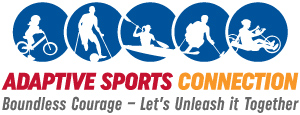Get in the boat. Kayaking is fun, relaxing, great exercise, and adventuresome depending on how YOU decide to participate.
At Adaptive Sports Connection, we provide opportunities for a quiet afternoon enjoying the outdoors or sprinting through the water. No matter your reason for getting in the boat, kayaking can be a great way to spend the day with family and friends!
Adaptive Sports Connection has a fleet of kayaks. Lessons, open paddling, special events, and group outings are scheduled throughout the summer.
All of our instructors are all certified by the American Canoe Association.

A Boat for Every Paddler
At your first lesson you'll paddle on Twin Lakes at the Adaptive Sports Connection Adventure Center. Twin Lakes is a flatwater area, a kayaker's term for a pond or lake with little to no current. Your instructors can help you get fitted into the right boat, show you any adaptations you'll need, and teach you the basic techniques of launching into the water, paddling and water safety.
What are your ultimate kayaking goals? Do you want to remain a recreational kayaker in mostly smooth water? Are you looking to compete in kayak races? Do you plan on taking a week-long trip through rough rapids? Your answers will determine which type of boat you'll need.
The most common boats are recreational boats, sit on tops, inflatable kayaks, tandem kayaks, white water boats, and sea kayaks.
Recreational boats are best for easy calm days, and are good for the casual kayaker.
Sit on tops are a nice choice for beginners as they're a bit wider, which makes them a bit more stable, and are easy to get out of quickly due to the kayakers positioning on top of the boat.
Tandem kayaks have space for two paddlers. They can be a great choice for younger kayakers who aren't ready to head out alone, or for athletes with disabilities that might not be able to safely paddle a boat without assistance.
Sea kayaks are designed for open water paddling, sit lower in the water to reduce cross winds and have smaller cockpit openings.
White-water boats are boats that can also be used in a variety of water conditions from smooth ponds to Class V rapids, but are also less stable than a recreational boat or a sit on top kayak.
Inflatable kayaks are great for camping trips or those with little storage space, as they can be deflated and transported in a backpack, but they can be a little more difficult to paddle for beginners and they're less rugged than a traditional kayak.

Adapting the Boat and Paddle
If you aren't able to easily hold a paddle or maintain the three points of contact within the boat, several simple adaptations can be made to the boat or paddle to ensure the stability of the kayaker within the boat, the rigidity of the boat and the mobility of the kayaker to escape from the boat if necessary. Adaptive Sports Connection volunteers are knowledgeable and experienced in these areas.
Amputation - For lower limb amputees, special prosthetic sockets exist to help you stay within the boat and maintain the three points of contact while paddling. Other options include strategically placed foam or airbags to help you with balance and push more evenly. Arm amputees may find that a hammerhead hand adaptation is required, or a one armed paddling rig which can be mounted on most boats.
Spinal Cord Injuries and those with balance issues - Depending on your level of injury, a special seat might be required to ensure you remain upright in the boat. Other adaptations include outriggers and strategically placed foam and airbags to help keep you balanced inside the boat.
Other Disabilities - If you are unable to paddle a boat by yourself, or just want some help your first time out, a tandem kayak is a great option. It allows you to have another paddler along to help keep the boat headed in the right direction.
Visual Impairment - Tandem kayaks can also be used for athletes with visual impairments. Kayakers with visual impairments can also paddle in a solo boat if they are able to safely paddle independently, opting to have guides in separate boats. Guides can transmit directions, warnings and other pre-determined information to the athlete with a visual impairment through a radio system or via a less high-tech call and return system.
Essential Eligibility Criteria
All persons must be able to do the following in order to paddle with Adaptive Sports Connection:
- Keep a life vest on while on the water.
- Stay seated in the boat.
- Keep their head above water in case of capsizing or while wearing a Type 1 life vest.
- Maintained a sealed airway in case of capsize.

